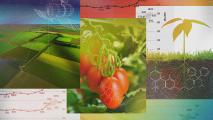Americans love meat. Love it! Worldwide, a person consumes on average 92 pounds of meat per year. The average American flesh-eater devours more than 265.
Most of that meat is poultry, which has dominated the dinner table slot since about the turn of the century. When you consider that the average chicken weighs 6 pounds at the time of slaughter, that’s, wow, so many dead birds.
That isn’t to say that Americans have given up on red or processed meats. Since the 1950s, red meat has been a symbol of American prosperity, and while our consumption has declined steadily since the beef lust of the 1970s, we still maintain our love of grilled steaks, juicy burgers, and cold-cut mountains sandwiched in bread. A majority of those polled in a 2012 survey said they eat red meat one to four times a week, a figure that excludes poultry and fish.
But even that may be too much. According to a meta-analysis published in JAMA Internal Medicine, just two servings of red meat and processed meats a week is associated with an increased risk of cardiovascular disease and death. And poultry isn’t an entirely benign alternative, either.
A red meat menace
The researchers analyzed six cohort studies, totaling 29,682 participants. The participants were surveyed about their eating habits and health. Baseline data were collected from 1985 to 2002 with follow-ups conducted until August 2016.
The researchers found two servings of processed meats a week to be associated with a 7 percent higher risk of developing cardiovascular disease — or an absolute risk difference of about 2 percent. Two servings of red meat were associated with a 3 percent higher risk — or about 1 percent absolute risk — and poultry was associated with similar risk. Fish consumption showed no increased risk.
The researchers then looked at all-cause mortality. They found a 3 percent higher risk of premature death for servings of red and processed meats, but no difference for poultry or fish.
“Modifying intake of these animal protein foods may be an important strategy to help reduce the risk of cardiovascular disease and premature death at a population level,” lead study author Victor Zhong said in a release.
In the heart or in the head?
You may now be thinking, “Wait! Wasn’t there a study last year that said it was okay to eat red meat?’ Yes, yes there was.
That meta-analysis, published in the Annals of Internal Medicine in October, was based on four systematic reviews of trials and studies looking at the link between red and processed meat consumption and cancer, cardiovascular disease, and mortality.
In one review, the researchers looked at 12 trials — totaling 54,000 participants — and found no significant association between meat consumption and the risk of heart disease or cancer. In the other three, they looked at studies of all-cause mortality, totaling four million participants. They found a very small reduction in risk but an uncertain association.
The researchers ultimately concluded that the links were small, the risks low, and the quality of evidence lacking. As a result, they recommended that adults continue to eat red and processed meats at their current levels and saw no reason to reduce consumption for health.
“This is not just another study on red and processed meat, but a series of high-quality systematic reviews resulting in recommendations we think are far more transparent, robust and reliable,” Bradley Johnston, an epidemiologist at Dalhousie University and the study’s corresponding author, said in a release.
However, many nutritionists and organizations like the American Heart Association and the American Cancer Society came out against the study and pushed for its publication to be withheld.
“This new red meat and processed meat recommendation was based on flawed methodology and a misinterpretation of nutritional evidence,” Frank Hu, chair of the Department of Nutrition at Harvard, said. “The authors used a method often applied to randomized clinical trials for drugs and devices, which is typically not feasible in nutritional studies.”
Nutritional data and you
What should we take away from this back-and-forth between nutritionists? First, both studies found that people who reduce red and processed meat consumption lowered their risk of premature mortality. They also found that the risk reduction was small.
The difference lies in how they believe that risk should be communicated to the public and how people should navigate their daily diets.
“The standards of evidence for the [scientific conclusions] are scientific matters and should not depend on extra scientific considerations” David Allison, dean of the Indiana University School of Public Health, told the New York Times added. “The standards of evidence for the [recommendations] are matters of personal judgment or in some cases legislation.”
Red meat and processed foods are associated with a low risk of developing cancer and heart disease. That’s a scientific consensus. That’s not the same as saying whether individual people should or should not consume those meats.
For example, if changing dietary habits reduces the risk of heart disease by 3 percent, that means only three in one hundred people would statistically see the benefits. The vast majority, 97 people, won’t. That’s the view of the Annals of Internal Medicine‘s recommendation: The current guidelines won’t change much on an individual level.
On the other hand, spread that risk across an entire population, and the salubrious effects become staggering. For the U.S.’s 327 million people, a reduced risk of 3 percent means 9,810,000 fewer people suffering from heart disease. Since health recommendations are generalized for an entire population, it makes sense that experts target individual advice with the public in mind.
Aaron Carroll, a physician and author of the Bad Food Bible, has written and spoken a lot on this topic. His advice is as follows: “If you’re eating multiple servings of red meat a day, then you may want to cut back. If you eat a couple of servings a week, then you’re likely just fine.”
Moving away from meat, nutritional research also agrees what the average person should eat on a daily basis. In an interview with Big Think, David Katz, director of the Yale Prevention Research Center, summed up the findings nicely:
You want to eat fish? Eat fish. You want to eat seafood? Eat seafood. You want to eat some lean meat? Do. You want to eat eggs? Do. You want to eat dairy? Do. But the bulk of your diet should be vegetables, fruits, whole grains, beans, lentils, nuts, and seeds. This is true all around the world where people do the best.
If you choose to eat meat, well, you do you. But you do you at your own risk.
This article was reprinted with permission of Big Think, where it was originally published.






